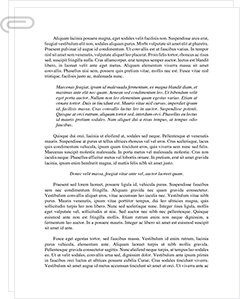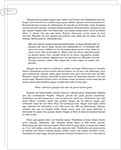 Study Document
Study Document
Response to 9/11 Creation of the DNI DHS and Iraq Invasion Essay
Pages:6 (1875 words)
Sources:4
Document Type:Essay
Document:#33442959
The Failures of the Intelligence Community Leading to 9/11IntroductionThe investigation of the 9/11 terrorist attacks revealed a massive failure of the U.S. intelligence community. Despite numerous signs pointing to an impending terrorist attack, the intelligence community failed to prevent the deadliest terrorist attack on U.S. soil. One of the main issues was the lack of coordination and seriousness among the various branches of US intelligence. This paper discusses these failures and also what lessons were learned and changes made by the US intelligence community.Failures Leading up to 9/11There are several key areas where the intelligence community, notably the Central Intelligence Agency (CIA) and the Federal Bureau of Investigation (FBI), failed to cooperate effectively with other law enforcement agencies leading up to 9/11.The communication and coordination problem between intelligence agencies has been widely discussed in reports and academic literature about the pre-9/11 intelligence failures.[footnoteRef:1] This lack of communication was a significant systemic issue that inhibited an effective response to the growing terrorist threat. The reason for it was the siloing of information within agencies, which meant that critical pieces of information were not shared or linked effectively. [1: Kimbra L. Fishel, "Intelligence Reform."American Intelligence Journal37, no. 1 (2020): 54-61.]A significant instance of this problem was the failure of the CIA to inform the FBI about the presence of future hijackers Khalid al-Mihdhar and Nawaf al-Hazmi in the United States in 2000.[footnoteRef:2] These two individuals were known to have attended an al-Qaeda meeting in Malaysia, yet their arrival in the US was not relayed to domestic law enforcement agencies in time. Had this information been shared appropriately, it might have been possible for the FBI to locate these individuals and disrupt the 9/11 plot.[footnoteRef:3] [2: Kevin Michael Derksen, "Commentary: The logistics of actionable intelligence leading to 9/11."Studies in Conflict & Terrorism28, no. 3 (2005): 253-268.] [3: Kevin Michael Derksen, "Commentary: The logistics of actionable intelligence leading to 9/11."Studies in Conflict & Terrorism28, no. 3 (2005): 253-268.]This problem was highlighted by the 9/11 Commission panel, which noted that "in late August, the Moussaoui arrest was briefed to the DCI and other top CIA officials under the heading 'Islamic Extremist Learns to Fly.'the news had no evident effect on warning."[footnoteRef:4] Zacarias Moussaoui, a French citizen of Moroccan descent, was in the United States in the months leading up to the 9/11 attacks, attending flight school in Minnesota. His behavior raised suspicions, leading to his arrest by the FBI in mid-August 2001 on immigration charges. At the time, the FBI suspected he could be planning a terrorist act involving a commercial airplane, but they were unable to secure a warrant to search his belongings due to insufficient evidence linking him to a foreign terrorist group. [4: Philip Shenon and Eric Lichtblau, Threats and Responses: The Overview, The New York Times, April 15, 2004. https://www.nytimes.com/2004/04/15/us/threats-responses-overview-sept-11-panel-cites-cia-for-failures-terror-case.html]The report points out that while Moussaoui's arrest was indeed briefed to top CIA officials, it failed to set off alarms as it should have. The report implies that the intelligence community failed to connect the dots between Moussaoui's behavior and the broader threat of a terrorist attack. The title of the briefing, "Islamic Extremist Learns to Fly," should have drawn attention to the possibility of a terrorist attack involving planes, especially given the intelligence the community had received indicating such a threat.The intelligence community's failure to respond effectively to the information on Moussaoui was symptomatic of a larger systemic issue. As the 9/11 Commission Report points out, the system was not "tuned" to recognize and respond to the significance of such information. The agencies had the pieces of the puzzle but failed to put them together, primarily due to communication and coordination problems. The Moussaoui case, among others, shows that more effective inter-agency communication and collaboration…
…identify credible threats. But the NSA's controversial mass surveillance programs was also part of these efforts, and that culminated with the Snowden whistleblowing event, which shocked US citizens and led to concerns about privacy invasions.Fusion CentersFusion centers were also developed in response to the communication and coordination failures that were identified after the 9/11 attacks. These centers were designed to facilitate information sharing among various agencies at the local, state, and federal levels. Their goal has been to better facilitate the sharing of threat-related information among partners. There are now several fusion centers across the United States, each of which focuses on a specific geographical area. Fusion centers are one of the best examples of how intelligence communities have responded to the problem of the siloing of information within agencies and between different levels of government.[footnoteRef:8] By bringing together agencies and allowing them to work more closely, it's much easier to connect the dots between different pieces of information and to identify potential threats. [8: Masse, Todd, Siobhan O'Neil, and John Rollins. "Fusion centers: Issues and options for Congress." LIBRARY OF CONGRESS WASHINGTON DC CONGRESSIONAL RESEARCH SERVICE, 2007.]ConclusionThe 9/11 attacks exposed serious flaws in the U.S. intelligence community's ability to prevent major terrorist attacks. These included a failure to share critical pieces of information, to recognize the significance of specific intelligence, and to adapt to the growing threat of non-state terrorism. In response to these failures, significant reforms were undertaken, including the creation of the Department of Homeland Security, the establishment of fusion centers, and the creation of the Director of National Intelligence position. These changes aimed to improve coordination, facilitate information sharing, and bring more focus and coherence to the U.S. counterterrorism efforts. Still, these reforms have not been without controversy, such as the mass surveillance program of the NSA and the invasion of Iraq based on faulty intelligence that linked Saddam Hussein…
Related Documents
 Study Document
Study Document
Homeland Security and Terrorism
Global Terrorism Right and left wing extremism, which are both forms of domestic or home-grown terrorism, have a rather long history in the U.S. Generally motivated by Marxist and communist ideologies, left wing extremism emerged as early as the late 19th century (White, 2016). Nonetheless, left wing extremism in the U.S. became more prominent in the 1960s and 1970s, with Weather Underground, Black Panthers, and Students for Democratic Society being the
 Study Document
Study Document
Intelligence Reform Following the Terrorist
Instead, by transferring budgetary control to the Director of National Intelligence, IRTPA forced the various intelligence agencies to unite under a single, coherent leadership, if only to ensure the continued flow of funds towards their respective projects. As with any government endeavor, the inertia of the Intelligence Community is maintained only so long as ample funds are continually available, so by tethering intelligence agencies' funding to inter-agency cooperation coordination,
 Study Document
Study Document
Dangerous Mismanagement
Intelligence Failures In an ever increasingly complex governmental infrastructure, the importance of communication, mission and strategy are of the utmost importance. The Department of Defense (DOD) and all of its law enforcement agencies are in a pervasive struggle to attain both accurate and actionable intelligence in order to perform their duties to the best of their capabilities and intentions. The purpose of this research paper is to explore the failure of the




